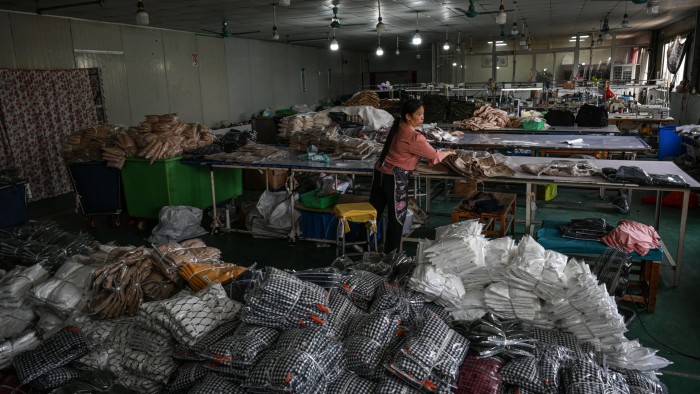On a recent trip to Pakistan, emerging markets investor James Johnstone travelled around in a Chinese-made BYD car to visit production facilities built by China’s Xiaomi to make cheap mobile phones.
The reach of some of China’s biggest brand names into the south Asian economy is symbolic of a shift in global trade that has been obscured by US-China tariff tensions.
It has been characterised not only by Beijing’s relocation of exports, but also by China shifting investments in low-cost manufacturing to developing nations, as it gears up for a wider trade war with the US.
It is also evidence of Beijing’s potential arsenal to fight back against Donald Trump’s imposition of tariffs that, at well over 100 per cent, could leave many Chinese goods out of the reach of US consumers who fuelled China’s export machine for decades.
More on The Future of Global Trade
“China is really interested in selling to the 7.5bn people who don’t live in the US”, says Johnstone, co-head of emerging and frontier markets at Redwheel, the investment manager. “And China is putting in the manufacturing capacity to sell to that global consumption base.”
With a trade surplus of more than $1tn over the past year to sustain, Beijing will soon be under pressure to replace now heavily restricted access to the US, home of world’s largest trade deficit, with new sources of demand.
China’s exports to big developing economies have already more than doubled since Trump was first elected president, from below $670bn in 2017 to $1.35tn in the year to February, representing more than a third of total exports, according to Jefferies analysts.

The share of China’s exports to G7 economies meanwhile fell below a third in the same period. “This is why China is less threatened by the Trump administration’s tariff agenda than many other countries,” Jefferies added.
This might also explain why Beijing has been so confident in retaliating against US tariffs. “China can do this because they think their economy is sufficiently diversified from manufacturing exports to the US,” Johnstone says.
Some of the trade diversion away from the US to other markets reflected Chinese investment in economies that were expanding trade with the US, such as Vietnam or Malaysia. This in turn has brought US accusations of Chinese goods being rerouted, sometimes via other countries’ assembly lines.
Yet these countries’ trade surpluses now stand to increase. “Targeting just China implies the US trade deficit with key partners will likely rise further,” says Gabriel Sterne, head of global emerging markets at Oxford Economics.
“In part, that’s because China now has huge incentives to circumvent tariffs by further integrating countries such as Vietnam into supply chains. And Trump would then respond,” Sterne adds.
A full-scale trade war fought by the US and China across international supply chains can still punish developing economies whose growth has tracked global trade volumes for decades.
“Over the last 25 years, there have rarely been occasions when the two have not been inextricably tied,” says Jahangir Aziz, emerging markets economist at JPMorgan.
“China and [emerging markets outside China] stand directly in the firing line: not just through near-term cyclical damage, but also damage to their growth models that are still fundamentally based on trade,” he adds.
“There are signs China wants to make the most of this moment,” says David Lubin, senior research fellow in global economy and finance at Chatham House, adding that there is evidence of growing trade with emerging markets.
In recent years, countries such as Pakistan and South Africa loaded up on imports of cut-price Chinese solar panels to help overcome rolling power blackouts and energy shortages.
Chinese-made panels and batteries are also enabling the rollout of solar energy in Saudi Arabia with some of the lowest costs in the world as the kingdom tries to diversify beyond oil.
But it has been a different story for emerging-market makers of steel, chemicals, textiles and low-cost electronics. These are classic examples of export industries that traditionally helped countries climb the ladder of economic development.
They have been hit by waves of cheap Chinese supply as Beijing has continued to support manufacturers in these areas, even as it is pursuing production of goods further up that ladder, such as electric cars.

“Developing countries have different attitudes about the penetration of Chinese goods into their markets,” Lubin says. “In one sense, they are happy to have access to cheap goods. But at the same time, there is also evidence to suggest that they are getting a bit frustrated with China’s market share in their domestic markets.”
South Africa imposed anti-dumping duties on Chinese steel last year as it battled to save its largest mill. Brazil, Turkey, and most recently India have taken similar measures. Countries such as Mexico, Indonesia, Thailand and Malaysia have also put up barriers on low-value imports such as garments, responding to the entry of Chinese ecommerce giants into their markets.
“Trade imbalances are not just a US-China irritant any more . . . emerging countries including India, Brazil, South Africa, and Turkey are launching trade defence cases to stave off what they see as injurious imports,” Rhodium Group, the research firm, said in March.
Beijing recently removed tariffs on imports from dozens of Africa’s poorest countries, after complaints on the continent about widening trade deficits with China.
But many of these nations will lack manufacturing capacity to take advantage. Larger developing economies will meanwhile be bracing for another influx of Chinese goods, diverted from US markets due to the steep increase in tariffs.
“It’s a slightly paradoxical situation, where everything Trump does seems to be a gift to China for delivering the global south into its lap,” Lubin says. “But China’s trade strategy is also a source of this conflict.”


